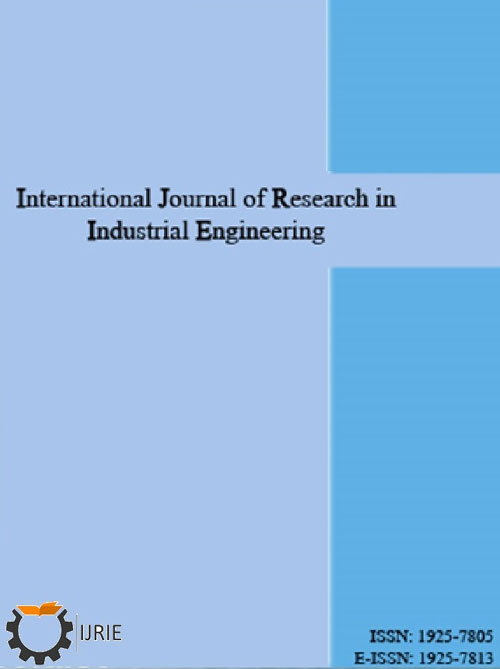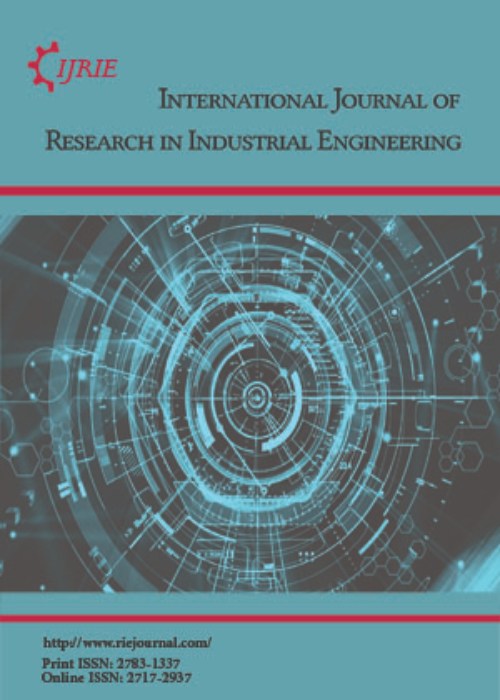فهرست مطالب

International Journal of Research in Industrial Engineering
Volume:8 Issue: 4, Autumn 2019
- تاریخ انتشار: 1399/04/28
- تعداد عناوین: 7
-
Pages 294-311Disaster relief logistics is considered to be one of the major activities in disaster management. This research studies response phase of the disaster management cycle. To do so, a multi-purpose integrated model for a three-level relief cycle logistics is provided under an uncertainty condition and on a periodic basis. In this model, inventory transfer, vehicle routing, distribution and sending relief goods are modeled on a periodic basis. In addition, in order to solve the proposed mathematical model, ultra-initiative particles swarm algorithm in combination with variable neighborhood search based on Pareto archive is proposed. To prove the efficiency of the proposed particles swarm algorithm, several sample problems are randomly selected considering the solved problems in the literature and are solved by particles swarm algorithm. These problems are also solved by genetic algorithm and the results obtained from these two algorithms are compared in terms of quality, dispersion and integrity indices. The results show that compared to genetic algorithm, particles swarm algorithm is more capable of producing more integrated, qualified and dispersed responses. Moreover, the results show that the solution time of genetic algorithm is less than that of the proposed algorithm.Keywords: Relief Logistics, Swarm Optimizations Algorithm, DEA
-
Pages 312-324
The expansion of production and development in the industrial sector, it is necessary to increase the investment in that. But limits of the financial resources to the investment and high risk for investments in industrial and production activities on the one hand, and the frequency of necessities and goals of the other hand, is inevitable to planning and priorities of investment. This study to follow, in condition of risk and uncertainty and the exist fluctuations in supply and demand market of industry, optimization of model to determine priorities and economic feasibility to the investment in this sector. This study, in three approach (TOPSIS, VIKOR and COPRAS), will examine its purpose. This research has been made for Gilan Province from 2012 to 2015. The results of this research involve the investment criteria and specify the priority of these sectors. The final results of this study indicate based on TOPSIS, VIKOR and COPRAS, the current pattern of investment in the industrial sector was not optimal and needs to be adjusted in the percentages and amounts of investment.
Keywords: TOPSIS, VIKOR, COPRAS -
Pages 325-338Inpainting or completion is used with the purpose of restoring damaged images and video frames. This paper proposes an applicable algorithm to inpaint corrupted subjects in video frames. To begin with, background and foreground (moving subject) are separated from each other in each frame, with the aim of getting to a more visually pleasant result. Static background inpainting is done using a patch-based method. To inpaint the corrupted moving subject, a subject-based method that is an improvement on the rigid object-based method is used in this study to consider the special issue of inpainting the human body. To fill in the holes created by occluding subjects the most appropriate template is found using a similarity measure which is based on both contour and pixel values. The inpainted video is acquired by superimposing the completed foreground on the inpainted backgroundKeywords: video inpainting, video completion, Contour, moving subjects separation
-
Pages 339-365Today, the use of risk assessment methods in various industries is expanding, as there are currently more than 70 different types of qualitative and quantitative risk assessment methods in the world. These methods are usually used to identify, control and mitigate the effects of hazards. Organizations should be able to select one or a combination of several types of risk assessment methods that are explored and studied in this article. In some cases, and for the direction of some sensitive processes, especially in the chemical industry, the production of explosive and combustion products such as the gas transmission company should be analyzed before determining the type of method of all methods and the best approach with regard to financial resources, requires qualitative or quantitative or qualitative and quantitative information, time limits, trained personnel limitations, the type of application of the risk identification method, the advantages, and disadvantages of each of these systems. Generally, acceptable risk levels are different for each organization or individual, depending on financial and economic resources, technological constraints, experienced human resources, discretion and management, and underlying risks such as hidden risks. Organizations usually require a system that, in addition to assessing their activities and processes can help them determine the risk situation, determine risk tolerance criteria, and accurately determine the exact risk of their processes, and ... lead them, depending on the complexity of the activity of each industry, the type of system that can bring them to the target. Is different. In this study, the assessment of the risks of gas Transmission facilities in the 9 regions, has been studied and reviewed. After identifying the various activities of the facility, which included three safety measures for equipment, personal and environmental health, and 28 sub-criteria, from previous studies and surveys, and staff comments. Then, using AHP, the fuzzy questionnaire was completed. Pairwise comparison of criteria and sub-criteria by experts and the use of excel software resulted in the weight of the sub-criteria and the compatibility rate. Then, using the verbal variables, five boost pressure facility with Fuzzy TOPSIS was ranked according to the relevant criteria, and the Rasht boost pressure gained the first rank.Keywords: Risk Assessment, fuzzy AHP, Fuzzy TOPSIS, Gas Transmission Facility
-
Pages 366-383One of the best techniques for evaluating the performance of organizations is data envelopment analysis. Data Envelopment Analysis (DEA) is a non-parametric method for evaluating the performance of decision-making units (DMUs) that recognizes the relative performance of DMUs based on mathematical programming. The classic DEA model was initially formulated for optimal inputs and outputs, But in real-world problems, the values observed from input and output data are often ambiguous and random. In fact, decision-makers may be faced with a specific hybrid environment where there are fuzziness and randomness in the problem. To overcome this problem, data envelopment analysis models in the random fuzzy environment have been proposed. Although the DEA has many advantages, one of the disadvantages of this method is that the classic DEA does not actually give us a definitive conclusion and does not allow random changes in input and output. In this research data envelopment analysis models in fuzzy random environments is reviewed.Keywords: Data Envelopment Analysis, Decision Making Unit, performance, Random Fuzzy Data Envelopment Analysis
-
Pages 384-393
Because of uncertainty in the real life applications, reaching to the optimal solution is always time consuming and even sometimes impossible. In order to overcome these limitations the fuzzy set theory is introduced to handle it but not only incomplete information but also indeterminate and inconsistent information which is common in real life conditions. In this paper, we have developed a new ranking function to solve a Fully Fuzzy Linear Fractional Programming (FFLFP). The ranking function is derived by replacing the non-parallel sides of the trapezoidal fuzzy number with non-linear functions. Various numerical examples are included and compared with the pre-existing methods.
Keywords: trapezoidal fuzzy number, ranking function, linear fractional programming problem, Fuzzy Numbers -
Pages 394-405Graphical passwords are the ways in which user click on the image or user can select the image to authenticate themselves instead of giving passwords. This technique is more secure that textual password techniques. In this article, the shoulder surfing preventive mechanism of graphical password authentication is given. Finally the login password system is proposed to deal with such type of problems. First time, we are introducing a modified approach is given to resolve the shoulder surfing based on recall and recognition based concepts. Usually it is seen that the most common vulnerability of graphical password is shoulder surfing attack. This research aims to analyze the usability feature of recognition based and recall based graphical password methods and present a technique to apply an image based password that is safe from the shoulder surfing attack. In the similar context, the purpose of this paper is to present an alternative way to apply the recall and recognition based technique that will be protective for guess through shoulder surfing. And this graphical technique will be easy to memories the authentication password and process of authentication.Keywords: graphical password, Security, Authentication


